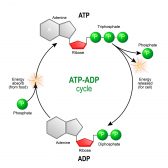Definition
noun
A crawling-like type of movement in which the cell forms temporary cytoplasmic projections called pseudopodia (false feet) towards the front of the cell.
Supplement
This type of movement is observed in amoebae (e.g. Amoeba proteus). Their cytoplasm consists of plasmasol (central fluid) surrounded by a more viscous plasmagel. The plasmagel is converted to plasmasol causing the cytoplasm to slide and form a pseudopodium in front to move the cell forward.
Cells that move this way are referred to as amoeboids. Apart from amoeba, other examples are cellular slime moulds (e.g. Dictyostelium discoideum), and human cells, particularly Kupffer cells of liver, monocytes, neutrophils, macrophages, and cancerous cells.
See also: pseudopodia, amoeboid.
Dictionary > Amoeboid movement
You will also like...

Community Patterns
Learn about community patterns and the ecological factors influencing these patterns. Revisit some of the ecosystems you..

ATP & ADP – Biological Energy
ATP is the energy source that is typically used by an organism in its daily activities. The name is based on its structu..

Non-Mendelian Inheritance
In this tutorial, find out more about certain types of inheritance that does not follow the Mendelian inheritance patter..

Freshwater Community Energy Relationships – Producers & Consumers
This tutorial looks at the relationship between organisms. It also explores how energy is passed on in the food chain an..

Running Water Freshwater Communities
This tutorial introduces flowing water communities, which bring new and dithering factors into the equation for possible..

Human Reproduction
Humans are capable of only one mode of reproduction, i.e. sexual reproduction. Haploid sex cells (gametes) are produced ..

